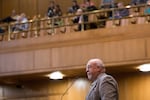For a state representative, Lynn Findley wields influence over a massive amount of ground.
Findley’s sparsely populated district includes all or part of five expansive counties, engulfing Southeast Oregon within its messy, vaguely rectangular bounds.

State Rep. Lynn Findley, R-Vale, introduces legislation on the House floor as the public gallery looks on at the Capitol in Salem, Ore., Tuesday, April 2, 2019.
Bradley W. Parks / OPB
The district, House District 60, is Oregon's largest by square mileage, but it stands out in another way: Nearly 5 percent of Findley's constituents don't necessarily live there by choice and couldn't vote for him even if they wanted to.
They’re state prisoners, and according to some, they’re being used to help pervert democracy.
“It is a loss of power,” said Mireya Rosas Barajas, a Willamette University senior. “For me, it comes down to people not being counted in their communities.”
A bill Rosas Barajas and others at Willamette University have revived this session would shake up how prisoners such as those in Findley’s district are considered on Oregon’s political map. It would ensure inmates aren’t counted as residents of a prison when legislative districts are redrawn in 2021. Instead, they’d be counted as residents of the place they lived before incarceration.
The bill, House Bill 2492, is part of a larger movement against what some call "prison gerrymandering," the act of bunching large groups of prisoners, who can't vote, into legislative districts far from their actual homes — and theoretically giving voters in those districts somewhat outsized power in the process.
“People aren't being accounted for in the area that they come from, and their families then lose that power,” Rosas Barajas said.
Findley's sprawling district is the best example in Oregon, though not remotely the only one. It includes two prisons: the massive Snake River Correctional Institution, which holds nearly 3,000 of the state's roughly 15,000 inmates; and the Powder River Correctional Institution, which has an additional 350 prisoners.

Snake River Correctional Institution holds nearly 3,000 of the state’s roughly 15,000 inmates.
John Rosman / OPB
Oregon House districts are drawn to contain nearly 64,000 residents. Findley's comes up a bit short of that, with just under 63,000 people — and around one in 20 is a prisoner. Advocates such as Rosas Barajas say this means the 60,000 people remaining have the same political representation as people in districts without prisons, giving them marginally more power.
As one 2017 paper on the issue put it: “When elections occur, prison-holding districts with smaller voting populations have the same opportunity to elect a representative as neighboring districts without prisons, and with many more voters, thereby granting certain communities more electoral power than they should rightfully have.”
The argument may seem academic, but states around the country are moving to end the practice.
Most recently, Washington's Legislature passed a bill to ensure prisoners are counted at their home addresses when the state redraws legislative districts. If Gov. Jay Inslee signs it, Washington will join Maryland, New York, California and Delaware in tweaking such policies. Eight other states are considering similar bills this year, according to the Massachusetts-based Prison Policy Initiative, an advocacy group that has tracked the issue for years.
Aleks Kajstura, the legal director at PPI, says counting inmates as residents of the prisons where they’re serving time can have a variety of impacts — including shifting power to more rural districts and incentivizing prison-district lawmakers to support tough-on-crime policies.
“If, like 10 percent of a district is incarcerated, they only have to represent 90 percent of the people,” Kajstura said. “It’s easier to represent a district where you don’t have a full constituency. It becomes easier to win elections and hold onto power.”
Oregon and other states have an understandable reason for counting inmates as residents of their prisons: That’s how the U.S. Census Bureau counts them during its decennial census. Oregon uses federal data when redrawing district maps every 10 years, an exercise that will next occur in 2021.
Under HB 2492, Oregon would instead use modified census numbers. By tracking prisoners’ addresses before they were incarcerated, the state would ask census officials to provide updated maps specifically for the purpose of drawing state and local political districts.
The Oregon Department of Corrections has taken a neutral stance on the bill — but also warned it would come at a cost.
“Currently, there’s no process in place for gathering someone’s last known address,” DOC assistant director Heidi Stewart told lawmakers in an April 17 hearing. “If we needed to verify that information, that would be a substantial workload increase for our staff.”
To help offset those concerns, legislators have considered asking DOC to count inmates as residing at the courthouse where they were convicted for purposes of the next census, then move to tracking actual addresses for subsequent counts.
“We just want to bring the districts into a real parity, or close to parity, so that people have even amounts of political power,” said Janet Lorenzen, a Willamette University sociology professor.
Lorenzen and her students are a chief reason why the redistricting issue is up for discussion this session. They’ve testified before lawmakers and met individually with legislators and their staffs on the issue.
Oregon has considered modifying how it counts prisoners before. In 2015, then-Sen. Chip Shields introduced essentially the same bill lawmakers are currently considering. That bill passed out of committee on a unanimous vote, but was never called up for a vote in the Senate.
This year is potentially the last chance for lawmakers to act before Oregon redraws districts in 2021. But proponents face a steep climb.

Rep. Paul Holvey, D-Eugene, (right) speaks with Rep. Nancy Nathanson, D-Eugene, in the House Chamber on April 30, 2019, in Salem, Ore.
Laurie Isola / OPB
“Certainly we have to convince those legislators that have these prisons in their districts that this isn't going to be harmful to them,” said state Rep. Paul Holvey, D-Eugene, a primary sponsor of the bill. “There's no gamesmanship going on here.”
Some of the state’s most powerful lawmakers represent districts with prisons.
Senate President Peter Courtney’s district in Salem includes the Oregon State Penitentiary, the state’s second-largest prison with a capacity of more than 2,250. House Speaker Tina Kotek’s Portland district includes the Columbia River Correctional Institution, which holds nearly 600 inmates.
HB 2492 could impact the boundaries of both districts. Courtney, who presided over the Senate when the 2015 bill died there, declined comment on the proposal. Kotek’s office said she is supportive.
Other legislators expressed skepticism the proposal was worth lawmakers’ time.
“There’s way bigger stuff that I’m looking at right now,” said state Rep. Denyc Boles, R-Salem, whose district encompasses three prisons, accounting for roughly 2.6 percent of its population. “This, in my opinion, is just something that not average people are talking about.”
Like Boles, Findley had never considered how prisoners were counted until the bill emerged this year. He says he doesn’t see the issue rising to the top at a time when lawmakers are taking up business taxes, a new cap-and-trade system, and other weighty measures.
“In the grand scheme of things, should we worry about it and should we spend a lot of time and effort on it?” Findley said. “I'm thinking not.”

Sen. Cliff Bentz, R-Ontario, asks questions during the Senate Judiciary Committee work session for House Bill 2625 on April 30, 2019.
Kaylee Domzalski / OPB
Not everyone is so sanguine. State Sen. Cliff Bentz, R-Ontario, represents a large Eastern Oregon district that includes three prisons. Back in 2015, he represented the House district Findley currently holds. And he supported the change.
“In my district, only 61,000 people are able to vote,” Bentz testified at the time. “The other 3,000 are in prison. They’re counted, but they don’t vote. Seems odd.”
These days, Bentz says he still thinks the issue is worth talking about, though he’s not sure a change would make much of a difference.
“I don’t want to say it doesn’t matter. That would not be true,” Bentz said. “If someone finds something that’s not fair, then you need to fix it.”
Bentz and other prison-district lawmakers also stressed one point when asked about the issue: They consider prisoners in their districts as constituents.
“I represent every person within the district boundary,” said Findley. “Will I have a town hall in the prison? I don’t know that. Do I have conversations with the prison and the superintendent? Yes, I do.”
